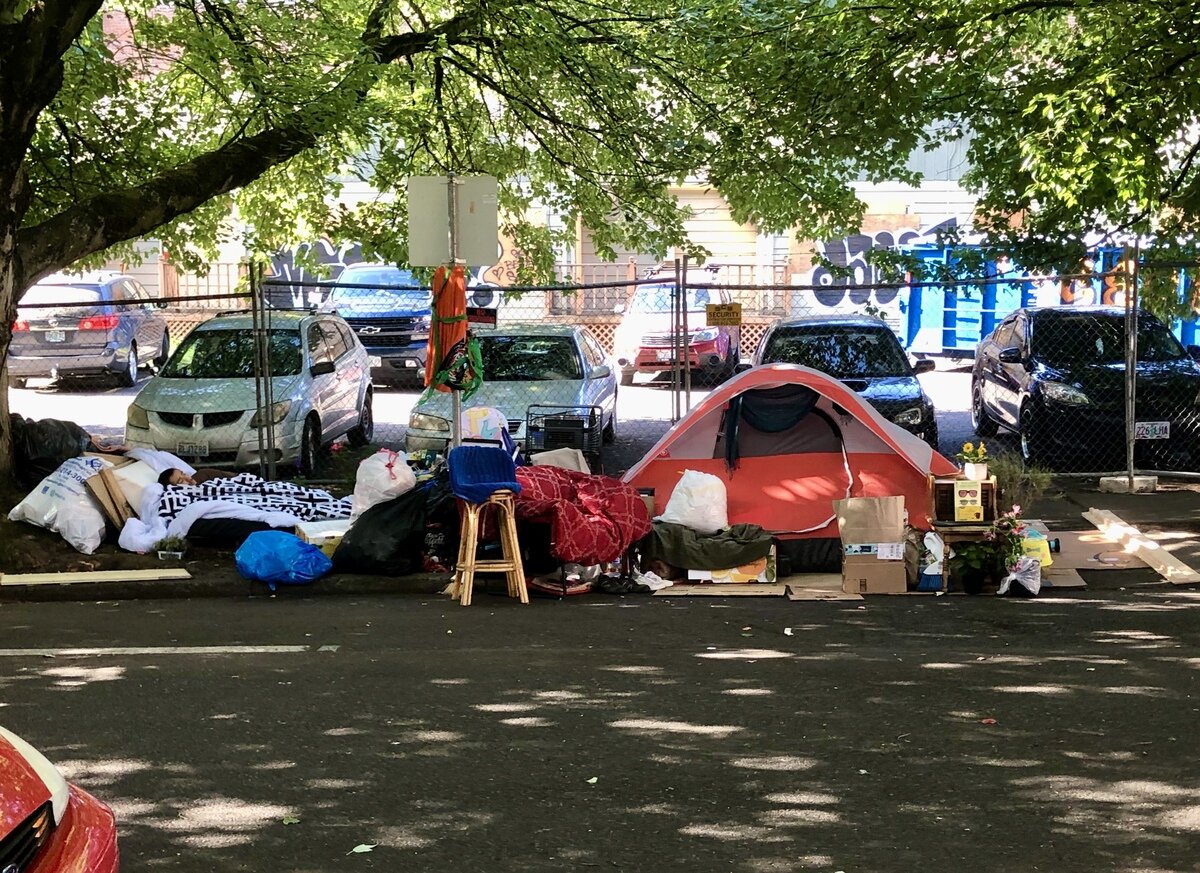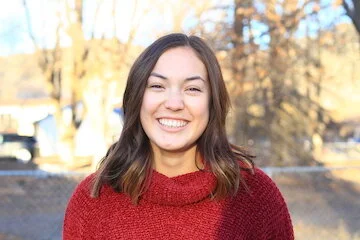Bringing Health Care to the Homeless: How Portland Street Medicine is Making a Difference
A homeless camp in the Alphabet District of Portland, Oregon, in July 2021. (Photo credit: Kylia Ahuna)
In October of 2020, when the nation was in the midst of battling the COVID-19 pandemic, an Oregon Public Broadcasting poll of 1,000 individuals living in Portland and the surrounding region made a startling revelation. Respondents’ main concern was not the virus; it was homelessness.
According to a national collection of data by the company security.org, Portland has one of the highest rates of homelessness in the United States. In 2020, the number of homeless in Portland was 4,173. Almost half of those were unsheltered—living in cars, parks, or on the sidewalks.
Numerous makeshift camps dot Portland’s neighborhoods. Often the colorful tents are reinforced by blue waterproof tarps and encircled by large trash bags holding the occupant’s belongings. Sometimes efforts are made to decorate the space. Outside one tent in the Alphabet District, a stack of books is propped up by a white ceramic pot, sprouting bright yellow flowers.
If you drive five minutes east of several camps in the Alphabet District, the glittering buildings of Oregon Health & Science University (OHSU) tower over the Willamette River. On rare sunny days, their glass exteriors reflect the water across the surrounding sidewalks in shimmering waves. On the more frequent overcast days, they catch the glint of rain.
Although just a few miles away from the homeless encampments in the Alphabet District, OHSU Hospital, rated by U.S. News & World Report as the top hospital in Oregon, is all but inaccessible to the people living on the streets.
Infographic by Kylia Ahuna
“No matter how many clinics you build, no matter how many hospitals you build, there’s a portion of the homeless population that will not come indoors and access health care,” says Dr. William Toepper, a volunteer at Portland Street Medicine (PSM).
PSM was founded in late 2018 to “meet people where they live.” Funded by donations and grant money, PSM provides care to the “most forgotten citizens.”
Outfitted in a sensible beige button-up and toting a large backpack, Dr. Toepper looks more like a seasoned hiker than a typical white-coat physician. Only the stethoscope draped around his neck gives him away. “Portland Street Medicine!” he shouts as he walks through the camps. “Does anyone need a doctor?”
PSM’s mission became more pressing during the recent COVID-19 pandemic when those living in group housing or in close proximity in homeless camps were especially at risk. The problem was compounded by the fact that PSM was unable to conduct as many camp visits because its doctors were busy dealing with the fallout from COVID-19 at their practices.
Instead, they focused on outreach. They put together first aid kits and distributed safety fliers about COVID-19 symptoms and ways to prevent the disease from spreading. Even with the pressure they were under, between July through September of 2020, PSM still managed to offer support to 1,177 vulnerable people with no permanent homes.
Homeless people were at higher risk for certain chronic health issues, even before COVID-19 was thrown into the mix. A 2018 study in the Journal of the American College of Cardiology concluded that a person with cardiovascular disease who lives on the streets is 60 percent more likely to die from complications than similarly-aged adults in the general population. The rate of obstructive lung disease among the homeless is more than double the national average. It currently affects 15 percent of the homeless living in San Francisco.
Those without shelter are most at risk. The mortality rate of unsheltered people in Boston was nearly threefold that of sheltered homeless, according to a 2018 study published by the Journal of the American Medical Association Internal Medicine. And in Los Angeles, a 2000 study of 1,051 homeless women found that unsheltered individuals were three times more likely to have poor physical health and 12 times more likely to suffer from poor mental health.
This makes the work of PSM especially important. By meeting unsheltered people where they live, at their cars, the park, or on the sidewalks, the group is trying to close the health disparity that exists not only between homeless and housed individuals, but also between the unsheltered and the sheltered. Although PSM keeps track of the vulnerable people they care for, there are no studies to assess the effectiveness of their efforts.
But similar programs in Maryland have documented positive results. In 2020, University of Maryland researchers studied the efforts of a health outreach team that offered health education and other resources to 127 neighbors facing homelessness and other hardships. The researchers found that more than half of those who met with a voluntary caregiver were able to develop a plan to manage their health.
Because living unsheltered and without resources is physically damaging, advocates believe that bringing health care to these people should only be a temporary fix. What homeless people really need are homes. An approach called Housing First aims to address this problem. “[P]eople need basic necessities like food and a place to live before attending to anything less critical, such as getting a job, budgeting properly, or attending to substance use issues,” according to the National Alliance to End Homelessness.
Research studies support this conclusion. For instance, Canadian researchers reported in 2015 that participants in a Housing First program experienced fewer alcohol problems after finding a home. Another study, from 2019, found that those with fixed homes felt less stressed and more able to manage their own health.
In the hope of getting more people off the street, Portland’s city council recently passed a bill called the Shelter to Housing Continuum Project. It will allow RVs and tiny homes to be parked on certain properties and used as housing. According to the bill’s proponents, although this policy does not directly help people find permanent housing, it may reduce the number of those who are unsheltered and improve the chances of vulnerable people finding a more stable place to live.
Bringing health care to the homeless may require multiple factors, including the continued support of the local government. “The reality is that there are no easy solutions here,” says Daniel Bissell, MD, a volunteer at PSM. “It’s gonna take a community-wide effort of us all pulling together.”



